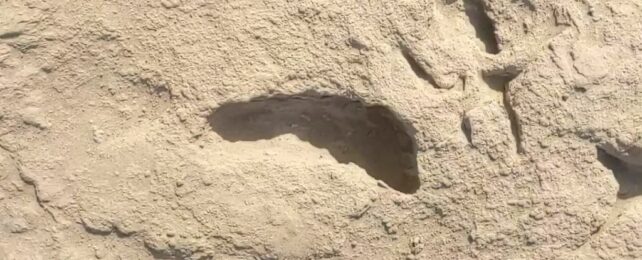A recent discovery of ancient footprints at the shores of Lake Turkana, Kenya, has provided stunning evidence of human ancestors coexisting roughly 1.5 million years ago. The fossilized tracks suggest two distinct species, Homo erectus and Paranthropus boisei, walked through the same area, possibly existing side by side and influencing each other's behaviors.
The tracks were uncovered at the Koobi Fora site by a research team led by the famed paleontologist Louise Leakey, who stated, "Their presence on the same surface, made closely together in time, places the two species at the lake margin, using the same habitat." This groundbreaking finding was published on November 28, 2024, in the journal Science.
The significance of these fossil footprints extends beyond mere evidence of coexistence; they present the first clear snapshot of two different hominin species sharing the same environment at the same time. Prior evidence was more speculative and based on skeletal remains with vague dating, making it difficult to confirm precise interactions. According to Kevin Hatala, the study's lead author from Chatham University, "This is the first direct snapshot of the two species together on the same immediate landscaping."
The discovery took place during excavations aimed at finding fossil bones. Researchers found well-preserved tracks imprinted on the lake margin after heavy rains revealed sediment layers previously obscured. The scientists utilized advanced 3D imaging technologies to closely analyze the footprints, leading to their conclusion about the interactions happening between the two hominin species.

Footprints are valuable because they provide insights about locomotion and behavior, which skeletal remains alone cannot offer. The researchers found distinct differences between Homo erectus and Paranthropus boisei footprints, indicating different walking patterns and anatomical structures. While Homo erectus showed traits similar to modern humans—indicating it walked with the heel-first approach—the other species exhibited flatter footprints, signifying different locomotor mechanics.
Hatala and his team identified eighteen footprints across the lake's edge, including one main trackway consisting of twelve distinct footprints likely made by Paranthropus boisei. This trackway measured about 26 feet long and suggested the individual was walking at a moderate pace. Meanwhile, three additional footprints attributed to Homo erectus were also found but displayed different characteristics, including smaller size and greater arch.
These findings challenge earlier notions of how our ancestors interacted. Rather than direct competition for resources, the researchers propose these hominins may have coexisted without significant conflict due to their different diets and foraging strategies. P. boisei likely consumed low-quality plant material, necessitating extensive chewing, whereas H. erectus appears to have been more versatile, using tools to access various food sources, including meat.
Historically, Paranthropus boisei, sometimes referred to as “Nutcracker Man” due to its large molars suited for grinding tough vegetation, is not considered our direct ancestor but exists on a separate branch of the evolutionary tree. H. erectus is often regarded as one of the predecessors to modern humans, showcasing traits like increased brain size and body proportions more closely resembling our own.
Among the foot discoveries, experts have speculated how these two species might have viewed one another. Hatala remarked, "I would expect the two species would have been aware of each other’s existence on the same landscapes, and they probably would have recognized each other as being ‘different.’" This intriguing idea introduces possibilities of various interactions, both positive and negative, similar to how chimpanzees and gorillas behave today.
The Koobi Fora site itself is known as one of the richest fossil locations on earth, providing valuable insights over the past three million years of human evolution. Nevertheless, as Hatala noted, "This proves beyond any question not only one but two different hominins were walking on the same surface, literally within hours of each other."
This discovery promises to reshape our understandings of how early hominin species behaved, interacted, and adapted to their shared environments. It emphasizes the complexity of our evolutionary history, illustrating the dynamic relationships of competition and coexistence among ancient human ancestors.
By positioning the two species so closely together temporally and spatially, this research not only sheds light on what life was like 1.5 million years ago at Lake Turkana, but it also enriches our comprehension of early human social structures and survival strategies. The conversation surrounding these early footprints will undoubtedly continue as more research emerges, giving us clearer insight not just about who we came from, but also how we came to be the humans of today.



